On 15 April 2014 I had the opportunity to speak about Christopher Columbus at the monthly meeting of the Cannon – Hinckley dinner group. The meeting was held in the Empire Room of the Joseph Smith Memorial Building in downtown Salt Lake City. What follows is the text of my presentation.
I am greatly honored by the invitation to speak to this august body. This is a group with a long and storied history involving the ancestors of many of us here tonight.
When the Liberty Stake was created in 1904, Hugh J. Cannon was called as the first stake president. My grandfather, Bryant S. Hinckley, served as his counselor for 18 years.
In 1925, President Cannon was called, for the second time, to serve as president of the Swiss-German Mission, and Bryant S. Hinckley succeeded him as president of the Liberty Stake. Three years later the editor of the Improvement Era died unexpectedly, and my grandfather sent a note to the President of the Church and to George F. Richards, Hugh Cannon’s father-in-law, and suggested that President Cannon be called as the new editor. Shortly thereafter the Brethren wired President Cannon with instructions to return home, where he was subsequently called as Editor of the Improvement Era.
In 1935, a few years after the death of President Cannon, the Liberty Stake was divided. Bryant S. Hinckley was retained as the President of the Liberty Stake, and his brother-in-law, Joseph L. Wirthlin, was called as the president of the newly created Bonneville Stake. So the Cannon, Hinckley and Wirthlin families have many connections – it was a small Church!
But I didn’t come here tonight to talk about the Cannons or the Hinckleys or the Wirthlins. You already know about them. I came to talk about Christopher Columbus, and you probably already know about him, too. My hope is that I can share with you some things you may not have already known about this man who has what is perhaps the most widely recognized name of anyone born in the last thousand years.
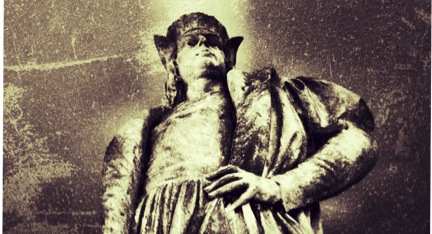 As a young missionary I served for three months in the city of Madrid where one of the most prominent monuments in this city of monuments is the great statue of Columbus. On the way home from my mission, I stopped to see my former mission president who was living in Maryland, just outside of the District of Columbia. After Kathleen and I were married, we moved to New York City and rented a small apartment just a few blocks north of Columbus Circle and a block west of Columbus Avenue. A quarter century later, our oldest daughter attended Columbia University. Her husband is a graduate of The Ohio State University, and there is nowhere he would rather be on a Fall weekend than in Columbus, Ohio on game day. Another son-in-law grew up in Columbia, Maryland, where his parents still live. Columbus, it seems, is everywhere.
As a young missionary I served for three months in the city of Madrid where one of the most prominent monuments in this city of monuments is the great statue of Columbus. On the way home from my mission, I stopped to see my former mission president who was living in Maryland, just outside of the District of Columbia. After Kathleen and I were married, we moved to New York City and rented a small apartment just a few blocks north of Columbus Circle and a block west of Columbus Avenue. A quarter century later, our oldest daughter attended Columbia University. Her husband is a graduate of The Ohio State University, and there is nowhere he would rather be on a Fall weekend than in Columbus, Ohio on game day. Another son-in-law grew up in Columbia, Maryland, where his parents still live. Columbus, it seems, is everywhere.
Children in almost every nation and culture know his name. But beyond the simple couplet that we learned as children, “In 1492, Columbus sailed the ocean blue,” most people know surprising little about this remarkable man and the way he shaped the modern world.
Yet the story of Columbus is one of the most remarkable and captivating stories in all of history. It is the story of a man who was foreordained to do just one thing, and that one thing would change the world more dramatically than any other single event over more than a thousand years of history. It is a story of rejection and ridicule; a story of perseverance in the face of opposition, a story of loyalty and treachery, a story of discouragement and of great courage. Columbus’s first voyage to America had enough adventure for a Hollywood blockbuster – mutiny, shipwreck, cannibals, desertion, and a storm so fierce on the return leg that Columbus sealed a record of the voyage in a barrel which he threw overboard in hopes that someone would find the message and know of his accomplishment if his ship went down.
And all this was just the first voyage across the Atlantic. He would complete three more voyages, filled with hurricanes, discovery, adventure, intrigue, betrayal and bravery. His fourth and last voyage would be particularly harrowing, coming to a near tragic end with a shipwreck that would leave him and his crew marooned for over a year on a Caribbean island with virtually no hope of rescue. They would be saved only through the courage of a loyal friend who undertook a daring open sea canoe voyage and successfully rowed to the Island of Hispaniola where he found help.
The story of Columbus is the story of an imperfect man, a man who made many mistakes and who made many enemies, but through almost unbelievable perseverance – some called it stubbornness – and what he claimed were God-given talents, achieved one great history-changing accomplishment. It is a story of a life that, in spite of triumph, ends in disappointment, sorrow and loneliness, and ultimately in redemption. No wonder the great historian from Oxford declared,
“History has all the world’s best stories, and the life of the weaver’s son who discovered America could hardly be matched even by the most inventive imagination.” (Felipe Fernandez-Armesto)
But in recent decades the story of Columbus has has been largely forgotten. He has become not so much a person as a symbol of all that has gone wrong in the modern world. He is accused of perpetrating genocide, enslaving and murdering Native Americans, and destroying the pristine environment and fragile ecology of the New World. He has become politically incorrect in every way, and on many college campuses, the former Columbus Day holiday has been renamed “fall break”.
Columbus has had a particularly bad rap over the past few decades. But the fact is, he was controversial during his own lifetime and his reputation has gone through multiple ups and downs over the centuries. For Latter-day Saints, however, Columbus has always had special place.
When I first read the Book of Mormon as a young teenager, Nephi’s prophecy about Columbus was one of the few verses that I clearly understood.
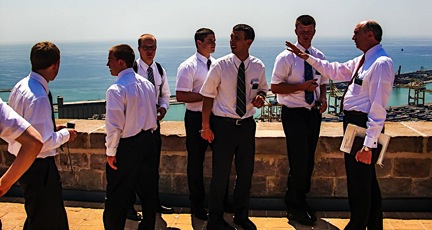 Years later, as a mission president in Spain, I took all newly arriving missionaries directly from the airport or train station to the top of a large castle that overlooks Barcelona and the Mediterranean Sea. While looking out over the “mission field” we read together Nephi’s short verse about Columbus. It seemed appropriate because Columbus is the only Spaniard mentioned in the Book of Mormon.
Years later, as a mission president in Spain, I took all newly arriving missionaries directly from the airport or train station to the top of a large castle that overlooks Barcelona and the Mediterranean Sea. While looking out over the “mission field” we read together Nephi’s short verse about Columbus. It seemed appropriate because Columbus is the only Spaniard mentioned in the Book of Mormon.
But one of the questions that began to surface in my own mind was, among all the great men who paved the way for the Restoration – Luther, Wycliff, Washington, Jefferson, Adams – “Why did Nephi single out Columbus?”
We think of Columbus as the discoverer of America, but he was almost certainly not the first European to cross the Atlantic to the Americas. We have reliable evidence, for example, that Vikings reached the shores of America nearly 500 years before Columbus. Yet their voyages did not result in any permanent settlements nor did they impact the history of the world – in fact, they were largely undocumented and forgotten. Columbus’s great achievement is not just that he succeeded in crossing the ocean and reaching the Western Hemisphere, but that he returned home safely and published his achievement to the world. He not only pioneered deep ocean sailing, but unlocked the secret of the trade winds. The route he established on his second voyage was used throughout the age of sail as the most direct route from Europe to the Caribbean. It was an unprecedented feat of seamanship, and it opened the way for others to replicate his voyages. He didn’t just discover America, he discovered the highway to America, and the routes he pioneered created a permanent link between the old and the New World.
For the first time since the waters receded from the Great Flood in the days of Noah, the land that God had kept hidden as a promised land was finally reconnected to the rest of the known world. And this changed everything. Prior to Columbus, the world had evolved in an increasingly fragmented and divided way. For example, sweet potatoes and corn grew only in the Western Hemisphere, other crops were unique to Asia. In fact, it was the desire for unique but highly desirable Asian spices and their absence in Europe that was one of the drivers of 15th century exploration.
With Columbus, the eons-old pattern of divergent development changed almost overnight, and a new age of convergence began. In our modern age, the same crops and species are found in similar climates on every continent. Who can imagine Italian cuisine without tomatoes, or Thai cuisine without hot peppers, or Ireland without potatoes? Or life without chocolate? Yet all of these products existed only in the Americas prior to Columbus. As one prominent historian noted, 1492 was the year the world began. It marks the beginning of the modern age, an age in which the millennia-long history of cultures and crops developing in isolation ended, and a new age of connection and convergence began. The fact that you can buy a Big Mac in Malaysia, Mexico, and Moscow is one of the legacies of Columbus.
For Nephi and for Latter-day Saints, the changes brought by Columbus were even more earthshaking. It was not just the modern age that Columbus made possible, it was the final dispensation, a dispensation in which it is not just Big Macs or chocolate that have become available across the planet, but in which the Restored Gospel can be taught to every nation, kindred, tongue and people.
Columbus’s voyages set in motion a series of events that would culminate with the mission of Joseph Smith. The realization that there was a new continent, previously unknown and unimagined, stirred the imagination of Europeans in a way that is hard for us to comprehend in today’s era when we can see every corner of the globe on Google Earth. And what no one knew in the 15th century is that this new continent housed a sacred record written on gold plates that would become the keystone of the Restoration. With the benefit of hindsight, we can better appreciate the observation made by a sixteenth century historian:
“The greatest thing since the creation of the world, save only the incarnation and death of Him who created it, is the discovery of the Indies.”
No voyage of any man in all of recorded history since Noah, would change the world as certainly and completely as the great voyage of discovery of Christopher Columbus. Columbus unlocked what Noah had locked away – the Promised Land of the Americas.
I think Nephi singled out Columbus because the Restoration really begins with Columbus. In fact, I think it is accurate to say that no single individual prior to Joseph Smith played a greater role in opening the last dispensation than Christopher Columbus.
In fact, the Prophet Joseph Smith is only other individual singled out in Book of Mormon prophecies regarding the Restoration. In a sense, these two men stand as bookends to the Restoration – Christopher Columbus at the beginning and Joseph Smith at the end.
There are remarkable similarities in the lives of these two men mentioned in ancient scripture. Both would fulfill their prophetic mission against seemingly unsurmountable odds, both would claim divine instruction and record revelation, both would claim divine keys, both would have keen and unique insights into the scriptures, both would have little formal education but achieve acclaim as geniuses, both would have an unshakeable conviction in the their own role in divine history, and both would leave behind them a world forever changed.
Nephi not only prophesied regarding what Columbus would do (cross the waters separating the land of the gentiles from the promised land), but why he would do it (the Spirit of God wrought upon the man).
What Columbus did is well known; why he did it is the subject of much speculation and misinformation, but Columbus himself was crystal clear about his motivations. My personal interest in Columbus was piqued by a statement I came across while living in Spain. Explaining himself to the Spanish monarchs in a letter written about 1501, Columbus declared:
“With a hand that could be felt, the Lord opened my mind to the fact that it would be possible to sail and he opened my will to desire to accomplish the project… This was the fire that burned within me… Who can doubt that this fire was not merely mine, but also of the Holy Spirit…urging me to press forward?”
Although Nephi’s prophecy was written in an unknown language on gold plates hidden in a hill on an unknown continent that Columbus was yet to discover, Columbus firmly believed that what he was doing was the fulfillment of prophecy:
“The Lord purposed that there should be something clearly miraculous in this matter of the voyage to the Indies. . . I spent seven years here in your royal court discussing this subject with the leading persons in all the learned arts, and their conclusion was that all was in vain. That was the end, and they gave it up. But afterwards it all turned out just as our redeemer Jesus Christ had said, and as he had spoken earlier by the mouth of his holy prophets.”
“I was not aided by intelligence, by mathematics or by maps. It was simply the fulfillment of what Isaiah had prophesied.”
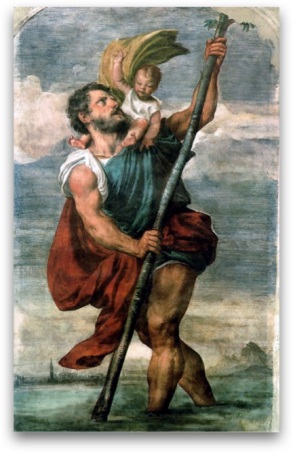 Even Columbus’s name was prophetic. According to legend, St. Christopher was born in the third century and was originally known as Offerus. He was a very large man with a great desire to find and serve the greatest king of all. Over a period of years, that search led him to enquire where he might find Christ, reputed to be the most powerful king of all.
Even Columbus’s name was prophetic. According to legend, St. Christopher was born in the third century and was originally known as Offerus. He was a very large man with a great desire to find and serve the greatest king of all. Over a period of years, that search led him to enquire where he might find Christ, reputed to be the most powerful king of all.
He was directed to a hermit who instructed him in the Christian faith. The hermit suggested that because of his size and strength Offerus could serve Christ by assisting people to cross a dangerous river, where they often perished in the attempt.
After performing this service for some time, a small child asked Offerus to carry him across the river. During the crossing, the river became swollen and the child seemed as heavy as lead, so much so that Offerus could scarcely carry him and found himself in great peril. When he finally reached the other side, he said to the child: “You have put me in the greatest danger. I do not think the whole world could have been as heavy on my shoulders as you were.” The child replied: “You had on your shoulders not only the whole world but Him who made it. I am Christ your king, whom you are serving by this work.” The child then vanished. Offerus became known as Christopher, literally Christ-bearer.
Columbus’s son, Ferdinand, wrote, “just as St. Christopher is said to have been so named because he carried Christ over deep waters with great danger . . . so the Admiral Christopher Columbus, invoking the aid of Christ in the perilous voyage, completed the journey to convert the Indians into members and inhabitants of the triumphant church of heaven.”
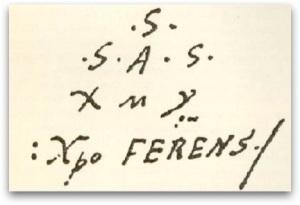 Christopher Columbus considered his name prophetic and viewed himself as the bearer of Christ to the peoples of the New World. He signed his first letter written from the New World with an enigmatic signature which he used for the rest of his life.. The meaning of the letters on the first three lines of this signature were never explained by Columbus, but the bottom line is clear: XPO FERENS is a combination of Greek and Latin words meaning, literally, Christ-Bearer.
Christopher Columbus considered his name prophetic and viewed himself as the bearer of Christ to the peoples of the New World. He signed his first letter written from the New World with an enigmatic signature which he used for the rest of his life.. The meaning of the letters on the first three lines of this signature were never explained by Columbus, but the bottom line is clear: XPO FERENS is a combination of Greek and Latin words meaning, literally, Christ-Bearer.
Perhaps the most remarkable thing about this very remarkable man was the clarity with which he understood his prophetic role.
Columbus had very little formal education. He probably acquired a working knowledge of Latin and basic mathematics in a primary school in Genoa, but had no formal education beyond that. Yet he learned to speak Portuguese and Spanish and became undisputedly the best navigator and sailor of his time. He was a great observer of nature. He not only understood the Atlantic trade winds, but made several other remarkable conclusions from observations on his voyages. On this third voyage, he became the first documented European to reach the American continent. Entering the Gulf of Paria, between Trinidad and the coast of Venezuela, he was caught in extremely fierce currents created by the flow of the Orinoco River into the sea. He assumed at first that Venezuela was just another large island, but after finally sailing into smoother water he had some time to think about what he had observed. Reviewing the deviations of the compass, he concluded, correctly, that the earth was not perfectly round. Reflecting on the great discharge of fresh water into the sea, he realized that no island could produce a river with a flow of the Orinoco (8 x the Nile), and correctly concluded that this was a new and hitherto unknown continent. [SLIDE: Quote on new continent] He then makes the remarkable statement in his log that not only is this a new continent, but that it is the continent where the Garden of Eden was located. As was so often the case with Columbus, both his data and his logic were flawed, but his conclusions were correct! Historian Paolo Taviani summarized Columbus’s intellect in this simple phrase: “The man was a genius.”
One of the least widely known aspects of Columbus’s life is that he records, on at least two occasions, hearing a Celestial voice. Although all of Columbus’s biographers include these incidents, they are unsure what to make of them. The most detailed revelation is recorded in Columbus’s account of his Fourth (and last) Voyage. He was anchored off the coast of present-day Panama, where his crew had built a small settlement in an effort to establish a permanent trading post. But relations with the natives turned sour, as they invariably did. Seeing an opportunity, about 400 Indians attacked the small village killing one Spaniard and wounding several others, including Columbus’s brother. After three hours of intense fighting, the outnumbered but better armed Spaniards ultimately prevailed.
While this battle was taking place, Columbus was alone on his ship anchored off-shore and suffering with a high fever. He heard the sounds of gunshots and realized that his men, including his brother, were under attack. Knowing the overwhelming number of Indians, he assumed when the sound of the muskets ceased, that all of his men had been killed. In his account of the incident, he wrote,
I was completely alone outside on this dangerous coast in a high fever and a state of great exhaustion. All hope of escape was dead. I struggled up to the highest point of the ship, weeping and calling in a trembling voice to … [the] Lord of Hosts in every direction for comfort, but there was no reply. Exhausted and groaning, I fell as if asleep and heard a very compassionate voice saying:
“O fool, slow to believe and serve thy God, the God of all! What more did he do for Moses or David his servant than he has done for thee? Since thou wast born, ever has He had thee in His watchful care. When He saw thee at an age that pleased Him, He caused thy name to sound marvelously in the land. The Indies, which were so rich a part of the world, He gave thee for thine own; thou hast divided them as it pleased thee, and He enabled thee to do this. Of the barriers of the Ocean Sea, which were closed with such mighty chains, He gave thee the key.”
Columbus concluded his account with these words:
I heard all of this as if I were only partially conscious, and I had no answer to give to words so true, but could only weep for my errors. He whoever he was who spoke to me, ended by saying, “Fear not; have faith; all these tribulations are written upon marble and are not without cause.”
Both the tone and content of the message are reminiscent of the Lord’s words to Joseph Smith in Liberty Jail, recorded in Section 122 of Doctrine and Covenants.
Interestingly, this revelatory experience of Columbus took place on April 6th.
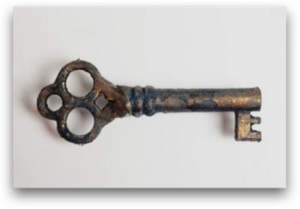 This visual analogy of keys in this revelation is glossed over by historians in general, but is particularly interesting to Latter-day Saints. The Doctrine and Covenants declares that Moroni held “the keys of the record of the stick of Ephraim” (D&C 27:5). According to Orson Hyde, Moroni “was with [Columbus] on the stormy deep, calmed the troubled elements, and guided his frail vessel to the desired haven.” It seems plausible that Moroni, who held the keys to bring forth the Book of Mormon, would have had a natural interest in Columbus, who would open the New World where “the record of the stick of Ephraim” was located. Whether or not Columbus received priesthood keys in the way that we understand them is a matter of speculation. However, the notion that Columbus was given keys to open the unknown ocean seems wholly consistent with his prophetic role and what we know about priesthood keys.
This visual analogy of keys in this revelation is glossed over by historians in general, but is particularly interesting to Latter-day Saints. The Doctrine and Covenants declares that Moroni held “the keys of the record of the stick of Ephraim” (D&C 27:5). According to Orson Hyde, Moroni “was with [Columbus] on the stormy deep, calmed the troubled elements, and guided his frail vessel to the desired haven.” It seems plausible that Moroni, who held the keys to bring forth the Book of Mormon, would have had a natural interest in Columbus, who would open the New World where “the record of the stick of Ephraim” was located. Whether or not Columbus received priesthood keys in the way that we understand them is a matter of speculation. However, the notion that Columbus was given keys to open the unknown ocean seems wholly consistent with his prophetic role and what we know about priesthood keys.
The contemporary historian, Bartholomew de Las Casas, declared,
“It is obvious that at that moment God gave this man the keys to the awesome seas; he and no other unlocked the darkness.”
Although Columbus is widely recognized among scholars as an extraordinary seaman and navigator, he was also a great scriptorian and a man of great faith. He had a remarkable command of the Bible. The most extensive document which he authored which is still in existence is a 168-page manuscript that consists largely of Biblical scriptures and related commentary. Many of his commentaries and conclusions sound remarkably familiar to Latter-day Saints.
For example, he saw in John 10:16 a key reason why God had inspired and enabled him to cross the sea. Columbus declared that the people he had found in the Indies were these other sheep. In fact, he refers to them as a “remnant people” of the children of Israel. By Latter-day Saint standards, it is a remarkable insight!
Together with preaching the gospel to all nations, kindreds, tongues and peoples, he saw the rebuilding of Jerusalem as a key event in the last age of the earth. These two events would presage a great new age, culminating in the Second Coming, and he viewed himself as a new John the Baptist, the forerunner or messenger of this new age.
“Of the new heaven and the new earth,” he wrote, “of which our Lord spoke in the Revelation of John and earlier by the mouth of Isaiah, he made me the messenger and showed me where to go.”
He also sensed an urgency in what he was doing:
“I said above that much of the prophecies remained to be fulfilled, and I believe that these are great events for the world. I believe that there is evidence that our Lord is hastening these things. This evidence is the fact that the Gospel must now be proclaimed to so many lands in such a short time.”
This sounds remarkably like something I recently read in the Ensign – Columbus felt an urgency to hasten the work of salvation over 500 years ago!
He admonishes others to act with faith in every righteous endeavor. His instruction sounds as if it might well be a modern-day mission president encouraging his missionaries in a zone conference:
“Saint Peter, when he leapt into the sea, walked upon it to the degree that his faith remained firm. Whosoever has the faith of a grain of mustard seed will be obeyed by the mountains. Whosoever has faith, ask and he shall receive, knock and it shall be opened unto you. No one should be afraid to undertake any project in the name of our Savior, if it is a just cause and appropriate for his holy service.”
Columbus died in relative obscurity in a rented house in Valladolid in northern Spain, surrounded by his two sons and a few close friends. No official from the royal court of Spain attended the simple burial; no bishop or dignitary was present. He died, as one historian noted, as he was born: unnoticed.
His reputation in Spain at the time of his death was at a low ebb, and it did not recover quickly. The early British settlers in North America, however, began to view Columbus as part of their peculiarly American heritage, and after the Revolutionary War he emerged as an iconic figure in the new nation, giving his name to its new capital. If Washington was the father of America, Columbus became the grandfather.
In 1823, the same Moroni who, according to Orson Hyde had guided Columbus across the ocean, appeared to Joseph Smith and showed him the plates which contained Nephi’s prophecy about Columbus. The Book of Mormon was published in 1830, and the Church of Jesus Christ of Latter-day Saints was formally organized on April 6 of that year, exactly 317 years after Columbus had heard a Celestial voice while anchored off the coast of Panama.
Columbus’s two great dreams would ultimately become reality as a result of the Restoration. He had grieved at the failure to evangelize the natives of the New World. But in our lifetime the Gospel has found root among the peoples and lands discovered by Columbus, with over 12 million Latter-day Saints living in the New World, half of those in Latin-America and the islands of the Caribbean.
Spain never launched a crusade to recapture Jerusalem and rebuild the temple, but on August 3, 1831, Joseph Smith dedicated land for a temple to be built in Jackson County, Missouri. There, at some future time, a new temple will be built as part of the New Jerusalem, fulfilling Columbus’s dream in a way he could not fully foresee.
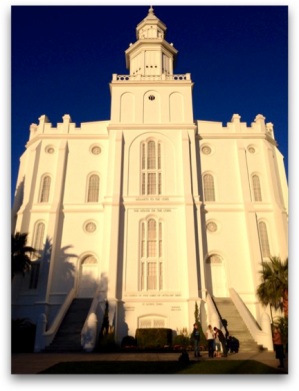 A few months after the dedication of the St. George Temple in 1877, Wilford Woodruff received a series of visions that impressed upon him the need to do temple work for many of the great men and women who had laid the foundations for the Restoration. On August 21, 1877, Christopher Columbus was baptized by proxy in the St. George Temple. Three days later, Wilford Woodruff ordained him a High Priest.
A few months after the dedication of the St. George Temple in 1877, Wilford Woodruff received a series of visions that impressed upon him the need to do temple work for many of the great men and women who had laid the foundations for the Restoration. On August 21, 1877, Christopher Columbus was baptized by proxy in the St. George Temple. Three days later, Wilford Woodruff ordained him a High Priest.
Of the one hundred eminent men who had been baptized in the preceding days, only four were ordained high priests. President Woodruff never explained why he ordained Columbus to the office of high priest, yet for Columbus, it seemed a singular and appropriate honor. He had striven throughout his life to serve both his sovereigns and his God. His service had often been flawed and imperfect and, except for a few brief moments and a few faithful friends, he had been rebuffed by kings and ridiculed by the wise and powerful men of his age. But he had succeeded in accomplishing what God had foreordained him to do and what Nephi had foreseen: wrought upon by the Spirit of God, this man among the gentiles had gone forth upon the many waters to the promised land.
With these sacred ordinances, administered in the new dispensation of which he had been a forerunner, Christopher Columbus was honored and recognized for what he always believed he was – the man who bore Christ across the uncrossable waters, the messenger of the new heaven and the new earth.
Thank you!

Fascinating read.
Thank you for this article! I appreciate a break from the vitriol that surrounds this man. Columbus may be small and weak in many ways, but it is by the small and weak God accomplishes his purposes. A great reminder.
Such an exciting story! May his courage and faith be felt by all the world!!
Does the Cannon-Hinckley group still exist? I’m a historian, wanting to ask someone some questions about it.
Yes, it still exists, but I am not a member currently so I’m not sure who is running it.